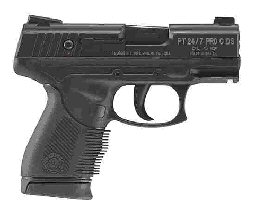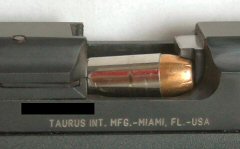Correcting
Feeding and Ejection Problems with a Taurus® 24/7
by Roy Seifert
Click here to purchase a
CD with this and all Kitchen Table Gunsmith Articles.
Disclaimer:
This article is for entertainment only and is not to
be used in lieu of a qualified gunsmith.
Please defer all firearms work to a qualified
gunsmith. Any loads
mentioned in this article are my loads for my guns and have
been carefully worked up using established guidelines and
special tools. The
author assumes no responsibility or liability for use of
these loads, or use or misuse of this article.
Please note that I am not a professional gunsmith,
just a shooting enthusiast and hobbyist, as well as a
tinkerer. This
article explains work that I performed to my guns without
the assistance of a qualified gunsmith.
Some procedures described in this article require
special tools and cannot/should not be performed without
them.
Warning:
Disassembling and tinkering with your firearm may
void the warranty. I
claim no responsibility for use or misuse of this article.
Again, this article is for entertainment purposes
only!
Tools
and firearms are the trademark/service mark or registered trademark
of their respective manufacturers.

For a
while now Taurus® has been manufacturing a line of
polymer-frame pistols called the Millennium series.
I’ve always been impressed with this pistol,
especially with the double-action/single-action striker
available in the Pro models.
The striker is cocked when the slide is pulled back,
and the pistol comes with an external safety to prevent the
striker from falling accidentally.
In case of a misfire, the striker can be activated
again with a long trigger pull thereby providing
second-strike capability without having to manually clear or
cycle the pistol. Taurus®
has improved on this line of pistols through the 24/7
models. I’m
always on the lookout for a better concealed-carry pistol,
so when I found a 24/7 compact in .45 ACP at a great price,
I decided to buy it.
Besides
having the DA/SA striker, this gun also comes with a decocking
feature built into the manual thumb safety, although the
manual suggests carrying the gun “cocked and locked” with
the striker cocked and the safety on.
Additionally, the gun comes with a loaded round
indicator, and a cocked indicator which provides a red, visual
indication that the striker is cocked.
Failure
to Feed (FTF)

The first
problem I noticed with this pistol was that it would not feed
hollow-point ammunition reliably. The
barrel has a built-in feed ramp that is very steep; almost,
but not quite vertical. Hollow-point
defensive ammo has a truncated cone or flat nose profile.
The first 2 or 3 rounds out of the magazine would
get jammed between the slide breech face and the feed ramp.
Tapping the bottom of the slide would cause the round to
feed, but this could be deadly in a defensive situation.
The
instruction manual that came with the pistol clearly states
that the gun is designed for 230 grain, full metal jacket (FMJ)
ammunition. I
believe this would be 230 grain, round nose, ball.
And in fact, the pistol fed full magazines of ball ammo
all day without a hitch. Unfortunately,
ball ammo is not the best defense ammo.

Hydra-
SXT® XTP® FTX®
Shok®
I was using
Federal 230 grain Hydra-Shok® ammo (far left in the photo
above).
I compared this to some Hornady 200 grain XTP® ammo
that I had (2nd from right in the photo above). The
XTP® ammo fed with no problems!
When I examined the bullet shapes I found an
interesting difference. Notice
in the above photo the Hydra-Shok® bullet on the left has a
more round profile, while the XTP® bullet second from the
right is more conical. Also,
the tip of the XTP® bullet appears to be slightly more
rounded than the tip of the Hydra-Shok® which is flatter and
sharper. Apparently
the rounder nose and narrower profile allow the XTP®
cartridge to feed more reliably.
That is why I always test my carry ammo for function
and reliability before trusting my life to it.
I also had
a box of Winchester
230 grain SXT® ammo (2nd from the left in the photo above). When
I compared this against the other cartridges, I found the SXT®
had a similar profile as the Hydra-Shok®, but they seemed to
feed reliably. On
closer examination the SXT® bullets were also slightly more
rounded at the tip then the Hydra-Shok® bullets.
However, if I left the magazine loaded with the SXT®
rounds, the spring would settle just enough to prevent them
from feeding. I
experienced the same feed jams.
I purchased
some Hornady® 185 grain Critical Defense® FTX® rounds (far
right in the photo above) which
have a longer, narrower conical shape. These
rounds seem to feed well, although there’s a slight hitch
when the round engages the feed ramp.
I left the FTX® round sit in the magazine for a few
days to allow the magazine spring to settle and they still fed
reliably. So
obviously the answer here is to use the right ammunition!
Failure
to Eject (FTE)

The other
problem this pistol had was it would not eject a live round.
Although this gun has second-strike capability, and a
misfire is very rare, still I could have a dead round and
would need to be able to eject it without having the round
hang up. As you
can see in the above photo, the nose of the round is jammed
between the barrel hood and the slide.
Part of the problem is the heavy recoil spring and
short stroke of the compact slide.
I can’t seem to get the slide back hard enough or
completely enough to eject the round.
The other problem is the large radius on the front of
the ejection port which prevents the round from clearing the
port. Once again,
this was using the Federal 230 grain Hydra-Shok® cartridge.
When I changed to the XTP® cartridge I was able to
eject a live round due to the narrow bullet shape.
When I attempted to eject a 230 grain ball round it,
too, would not eject. As
stated before I don’t normally shoot ball ammo, but overall
length seems to be another contributing factor.

I wanted
the pistol to eject hollow point ammo reliably so I carefully
took my high speed rotary tool with a small diameter grinding
stone and reduced the radius of the front corner of the
ejection port. This
corner needs to be round, not square, to prevent the slide
from cracking at this location.
I polished the new radius with a Cratex bit, then cold
blued the exposed metal. This
might void the excellent Taurus warranty, but I’d rather
have reliability.
Summary
Many
guns are somewhat ammo specific, and this compact pistol is no
exception. To feed
reliably it requires a cartridge with a conical, more rounded
tip. Because
hollow point ammo is slightly shorter than ball ammo, my
“adjustment” to the front corner of the ejection port
allowed me to consistently eject a live round.
I am now using the Hornady® 185 grain Critical Defense®
FTX® ammo. This
cartridge feeds and ejects reliably with the added benefit of
better expansion.
|